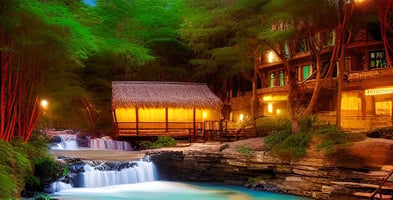Leadership is a crucial element in the tourism and hospitality industry, as it plays a vital role...
America's Most and Least Balanced Tourist Destinations
America's Most and Least Balanced Tourist Destinations
Introduction
In the realm of travel, finding destinations that strike a harmonious balance between attractions, dining options, accommodations, and shopping venues is a rare gem. Such equilibrium not only enriches the tourist experience but also fuels the local economy. This blog post explores America's most and least balanced tourist destinations, shedding light on their unique characters and the implications of their tourism products.
The Most Balanced Destinations
1. Twentynine Palms, CA
Nestled in the heart of the Mojave Desert, Twentynine Palms offers a unique blend of natural wonders and cultural experiences. With a ratio of attractions to restaurants at 1:1.2, and accommodations and shopping also well-represented, visitors can immerse themselves in the stark beauty of Joshua Tree National Park and explore local art galleries and boutiques.
2. Luray, VA
Luray, Virginia exudes a charming small-town vibe, surrounded by the stunning backdrop of Shenandoah National Park. Here, the ratio of attractions to dining options is a balanced 1:1.4. Visitors can explore the renowned Luray Caverns or embark on scenic drives along Skyline Drive, all while enjoying a diverse culinary scene and quaint shopping spots.
3. Frankfort, KY
The capital city of Kentucky, Frankfort, offers a historical tapestry coupled with a vibrant arts scene. Boasting a ratio of 1:2 for attractions to restaurants, visitors can delve into the rich political heritage at the State Capitol, while enjoying an array of dining experiences. Accommodations and shopping options are also available, though more sparingly.
4. Reedsport, OR
Reedsport, nestled along the Oregon coast, strikes a balance between natural beauty and local amenities. With a ratio of attractions to dining options at 1:1.5, visitors can revel in the coastal splendor of the Umpqua River while savoring a variety of culinary delights. Accommodations and shopping outlets are also thoughtfully integrated into the destination.
5. Hurricane, UT
Utah's Hurricane beckons outdoor enthusiasts with its stunning landscapes and recreational opportunities. The ratio of attractions to dining options stands at a commendable 1:1.6. Here, visitors can hike through the breathtaking Zion National Park and relish diverse dining experiences. Accommodations and shopping, though slightly fewer in number, are well-appointed.
6. Salem, MA
Salem, Massachusetts, known for its bewitching history, offers a compelling blend of attractions and amenities. With a ratio of 1:1.9 for attractions to dining options, visitors can explore the enigmatic Salem Witch Trials history while enjoying a plethora of dining choices. Accommodations are comfortable, and shopping options add to the allure of this bewitching town.
7. Leesburg, VA
Leesburg, situated in Virginia's wine country, exudes a quaint, historic charm. The ratio of 1:2.1 for attractions to restaurants indicates a balanced offering. Visitors can indulge in wine-tasting experiences and explore local history, complemented by a thriving dining scene. Accommodations, though fewer, provide a cozy retreat, and shopping options are thoughtfully curated.
8. Galena, IL
Galena, Illinois, steeped in 19th-century charm, offers a nostalgic journey back in time. The ratio of attractions to restaurants, though slightly skewed towards dining at 1:1.2, still ensures a well-rounded experience. Visitors can meander through historic sites and enjoy diverse dining options. Accommodations are plentiful, and shopping adds to the town's allure.
9. Cleelum, WA
Nestled in the Cascade Mountains, Cleelum, Washington, entices nature enthusiasts and seekers of tranquility. The ratio of 1:1.8 for attractions to dining options provides a balanced foundation. Visitors can relish outdoor activities and savor a variety of culinary experiences. Accommodations and shopping options are well-represented, enhancing the visitor's stay.
10. Boulder City, NV
Boulder City, Nevada, neighboring the iconic Hoover Dam, offers a blend of natural wonders and recreational opportunities. With a ratio of 1:1.8 for attractions to dining options, visitors can explore the engineering marvel of the Hoover Dam and enjoy diverse dining experiences. Accommodations and shopping venues round out the visitor's experience.
The Least Balanced Destinations
1. Tulsa, OK: A Culinary Overload
Tulsa, Oklahoma, known for its vibrant arts scene and rich cultural heritage, is a city that boasts an impressive array of dining options. However, this abundance comes at the cost of a less diverse selection of attractions, accommodations, and shopping venues. With a staggering ratio of attractions to restaurants at 1:18.8, Tulsa leans heavily towards its culinary offerings. While this culinary abundance caters to food enthusiasts, it may overshadow other aspects of the visitor experience.
2. Kansas City, KS: A Gastronomic Paradise
Kansas City, Kansas, embraces its reputation as a haven for food lovers. The city's culinary scene is undoubtedly thriving, offering a wealth of dining options. However, this culinary richness is not evenly matched with an equivalent diversity in attractions, accommodations, or shopping venues. With a ratio of attractions to restaurants at 1:17.2, the city's focus on dining experiences is apparent. While this caters to gastronomes, it may leave other aspects of the tourist experience in the shadows.
3. Wichita, KS: Savoring the Flavors
Wichita, Kansas, shines as a city with a flourishing dining scene. The culinary options here are diverse and plentiful. However, this focus on dining may come at the expense of a more balanced tourist experience. The ratio of attractions to restaurants, standing at 1:16.7, highlights the city's emphasis on gastronomy. While this caters to food enthusiasts, it may lead to a relative lack of diversity in other facets of the visitor experience.
4. Houston, TX: A Culinary Metropolis
Houston, Texas, stands as a sprawling metropolis renowned for its culinary diversity. The city's dining scene is nothing short of extraordinary, offering an abundance of choices. However, this culinary richness may overshadow other aspects of the visitor experience. With a ratio of attractions to restaurants at 1:15.7, the city's focus on dining is palpable. While this caters to food aficionados, it may lead to a relative neglect of other dimensions of the tourist experience.
5. San Antonio, TX: A Flavorful Fiesta
San Antonio, Texas, is a city that celebrates its culinary heritage with gusto. The city's dining options are as diverse as its cultural tapestry. However, this culinary abundance may tip the scales in favor of dining experiences at the expense of other facets of the visitor experience. With a ratio of attractions to restaurants at 1:13.9, the city's focus on dining is evident. While this caters to food connoisseurs, it may lead to a relative dearth of diversity in other aspects of the tourist experience.
6. Fort Worth, TX: Savoring the Southwest
Fort Worth, Texas, embraces its role as a culinary hub, offering a taste of the Southwest. The city's dining scene is vibrant and varied. However, this emphasis on dining may overshadow other dimensions of the visitor experience. With a ratio of attractions to restaurants at 1:15, the city's focus on culinary experiences is clear. While this delights food enthusiasts, it may lead to a relative lack of diversity in other facets of the tourist experience.
7. Fresno, CA: A Culinary Landscape
Fresno, California, stands as a city with a thriving culinary landscape. The dining options here are abundant and diverse. However, this culinary richness may come at the expense of a more balanced visitor experience. With a ratio of attractions to restaurants at 1:15.1, the city's emphasis on dining is evident. While this caters to food lovers, it may lead to a relative lack of diversity in other dimensions of the tourist experience.
8. Pittsburgh, PA: A Culinary Melting Pot
Pittsburgh, Pennsylvania, is a city known for its culinary diversity and innovation. The city's dining scene is a testament to its vibrant cultural tapestry. However, this culinary richness may overshadow other facets of the visitor experience. With a ratio of attractions to restaurants at 1:14.2, the city's focus on dining is apparent. While this caters to food enthusiasts, it may lead to a relative neglect of other dimensions of the tourist experience.
9. Dallas, TX: A Gastronomic Journey
Dallas, Texas, is a city that takes pride in its culinary offerings, offering a gastronomic journey for visitors. The dining options here are as diverse as the city itself. However, this culinary abundance may come at the expense of a more balanced visitor experience. With a ratio of attractions to restaurants at 1:13.8, the city's emphasis on dining is evident. While this delights food aficionados, it may lead to a relative dearth of diversity in other facets of the tourist experience.
10. Garden Grove, CA: A Feast for the Senses
Garden Grove, California, is a city that celebrates its culinary diversity. The dining options here are rich and varied. However, this culinary richness may overshadow other aspects of the visitor experience. With a ratio of attractions to restaurants at 1:14.1, the city's focus on dining experiences is clear. While this caters to food connoisseurs, it may lead to a relative lack of diversity in other dimensions of the tourist experience.
Causes of Overabundance of Restaurants in Certain Destinations
The prevalence of an excessive number of restaurants in certain destinations can be attributed to various factors, often driven by economic, cultural, and demographic considerations.
1. Economic Factors
a. Chain Establishment Dominance
In many cases, the overabundance of restaurants can be linked to the proliferation of chain establishments. These franchises often have the financial backing and market research capabilities to saturate a particular area. Consequently, they can outcompete independent eateries, leading to a disproportionate number of dining options compared to other amenities.
b. Employment Opportunities
The restaurant industry can provide a substantial number of jobs, especially in areas where there may be limited employment opportunities in other sectors. This can incentivize entrepreneurs and corporations to invest in the restaurant business, further contributing to the surplus.
c. Tourism-Driven Economies
Destinations heavily reliant on tourism often see an influx of restaurants to cater to the transient population. This is particularly true in areas known for their culinary offerings, where the demand for dining options is high.
2. Cultural Factors
a. Culinary Identity
Cities or regions that have established themselves as culinary destinations may experience an influx of restaurants seeking to capitalize on their gastronomic reputation. This phenomenon is often observed in cities with renowned food scenes, where aspiring chefs and restaurateurs flock to join the ranks of established eateries.
b. Foodie Culture
The rise of food culture and the advent of food-centric media have created a demand for diverse and unique dining experiences. As a result, cities with a thriving foodie culture tend to attract a higher number of restaurants.
3. Demographic Considerations
a. Population Density
High population density areas, such as bustling cities, can support a larger number of restaurants due to the larger consumer base. This can lead to an overrepresentation of dining options compared to other amenities.
b. Consumer Preferences
Local consumer preferences play a significant role in shaping the restaurant landscape. If a community highly values dining out and exploring different cuisines, it can lead to a higher concentration of restaurants.
4. Competition and Market Dynamics
a. Fierce Competition
In highly competitive markets, restaurants may open in close proximity to one another to attract customers. This can result in clusters of dining establishments, further contributing to the overabundance.
b. Real Estate Availability
The availability of suitable real estate can also influence the concentration of restaurants in a particular area. Zones with ample commercial space may naturally draw more dining establishments.
Conclusion
While an abundance of restaurants can be a boon for food enthusiasts, it's crucial to consider the broader implications for the local economy and the overall tourist experience. Striking a balance between dining options and other amenities is essential for creating a well-rounded tourism product that benefits both the community and visitors alike. By understanding the factors that drive the overabundance of restaurants, we can work towards creating more balanced and sustainable tourist destinations.



